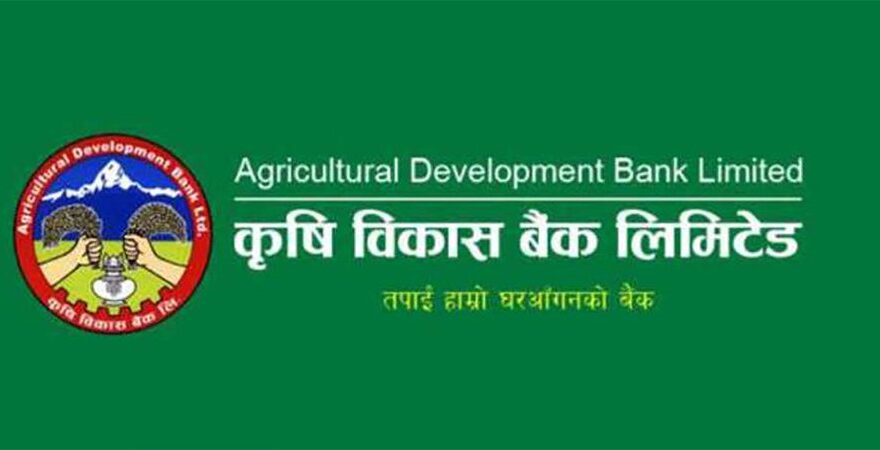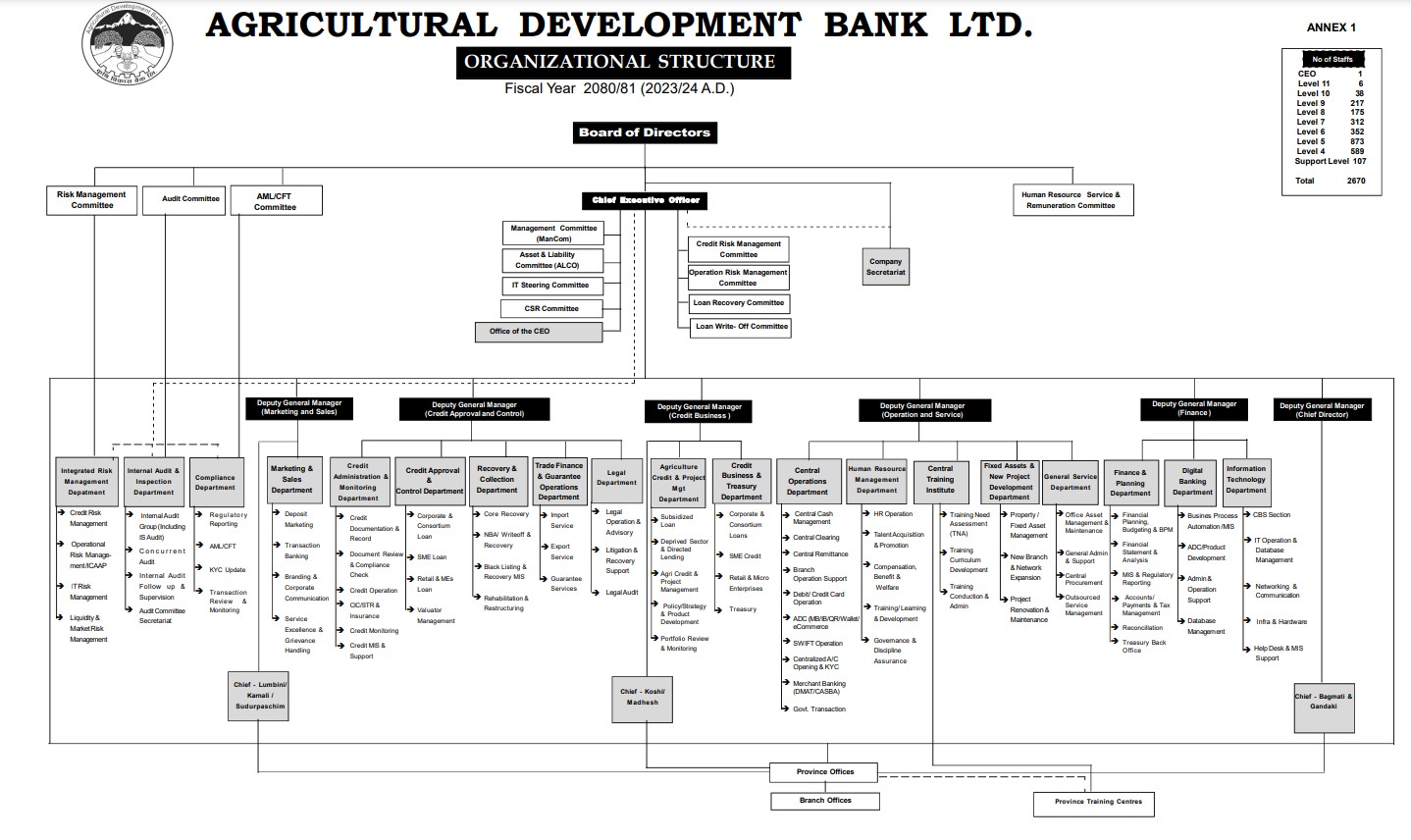
This article covers the following topics
- Establishment of Agriculture Development Bank Limited
- Development phases of Agriculture Development Bank Limited
- Mission, Vision, and Objectives of Agriculture Development Bank Limited
- Organizational structure of Agriculture Development Bank Limited
- Capital ownership structure of Agriculture Development Bank Limited
Establishment of ADBL
With the main objective of providing institutional credit for enhancing the production and productivity of the agriculture sector of the country, the Agriculture Development Bank of Nepal (ADBN) was established in 1968 AD under the Agriculture Development Bank Nepal act 1967 as a successor to the cooperative bank.
The land reform saving cooperatives were merged with this bank in 1973. Subsequent amendments to the act empowered the bank to extend credit to small farmers under group liability and expand the scope of financing to promote cottage industries. The amendment also permitted banks to engage in commercial banking activities for the mobilization fo domestic resources.
The bank worked as a premier rural credit institution since its establishment, contributing substantial agriculture credit supply in the country. Rural finance has been principle operation area of this bank in the past. However, the bank is also involved in commercial banking operations since 1984 to provide commercial banking services.
The bank has a 51 % share of the Government of Nepal and 49 % of the general public. Most of its shareholders are customers and employees.
After the enactment of the Bank and Financial Institutions Act (BAFIA) took all the BFIs under its umbrella and abolished all the acts related to BFIs including the ADB Act 1967. Since then ADBN has been working as a public limited company registered under the Company Act 2006 and has been licensed as “A” class financial institution by Nepal Rastra Bank from 2006.
Having a glorious history of more than 53 years, the bank is one of the leading commercial banks in the country. With its investment in agriculture, industry, trade, commerce and households, the bank has above 1.2 million happily satisfied customers.
Just like its slogan that “Bank with complete banking solution at your own doorstep“, its is expanded all over the 7 provinces, 77 districts, with its 278 offices while providing comprehensive services with complete banking solution. The bank has main motto of promoting rural agriculture, productive and deprived sector. The bank is committed to provide best banking service through its wide-spread network.
What are the Mission Vision Objectives of ADBL
Vision
- The bank of choice for shared prosperity.
Mission
- Ensure customer service excellence
- Attain sustainable business growth with complete financial solutions.
- Contribute for economic and social prosperity of the nation.
- Uphold ethical practices, governance and transparency at all levels.
- Assure profitability for shared prosperity.
[Mission and Vision are changed in tenure of CEO Govinda Gurung in fiscal year 2081/81]
Organizational Structure of ADBL
Following are the organizational structure of the Agricultural Development Bank Limited.
1) Board of Director – BoD
Board of Director (BoD) is the apex body of the bank. It formulates policies as well as strategies and provide guidance to the management. The board comprise a total of 7 members. 3 Member representing Government of Nepal and 3 members represent shareholders. Besides these, one member is nominated the board as per the BAFIA as independent director.
- Total – 7 Members
- Government of Nepal – 3 Members
- Shareholder – 3 Members
- As per BAFIA – 1 Member
2) Committees
There are 4 committees in the board. They are
- Risk Management Committee
- Audit Committee
- AML/CFT Committee
- Human Resource Facilitation Committee
These committees are formed to help the strengthen internal control and corporate governance for the BoD.
3) Management Committee
Management committee is responsible for day to day operation of the bank. Chief Executive Officer (CEO) lead the management committee. The CEO is closely assisted by 6 DGM. i.e
- Chief credit officer – CCO
- Chief operation officer – COO
- Chief service officer – CSO
- Chief human resource officer – CHRO
- Chief finance officer – CFO
- Chief agriculture credit officer – CACO
25 department head help management committee. Likewise, CEO is also supported by asset and liabilities management sub-committee, project management unit, grievance handling and relationship management for better internal control and business operation.
Operational structure
There are thee-tier of organizational structure in ADBL. They are
- Head office
- Provincial office
- and field office (Branch Officer)
Field offices are further classifies into branch office A, B,C, D and other branch offices. The head office is policy making body at the top, the field office are implementing unit at the bottom, and provincial office with monitoring and supervisory role are in between. There are 2670 employees all around Nepal as of FY 79/80.
ADBL is serving all over the 7 provinces & 77 districts of the nation with its 278 offices. While providing comprehensive services with complete banking solution, the bank has main motto of promoting rural agriculture, productive and deprived sectors. The bank is committed to provide best banking services through its widespread network and help the government from its part, to achieve the aim of: “Prosperous Nepal, Happy Nepali”.
Capital Ownership Structure of ADBL
- Authorized capital – 25 Arba
- Authorized equity share capital – 16 Arba
- Authorized preference share capital – 9 Arba
- Issued and paid-up capital – 18,620,627,763
From general issued share capital NRs.13,187,915,763/- (51% of Nepal Government and 49% of general public) & From non-cumulative irredeemable preference share capital NRs.5,432,712,000/- (100% of Nepal Government).
Both equity and preference shares are of NRs. 100 each.

Click here to view the latest ADBL Organigram (FY80/81)
ADBL Important Questions
- Briefly highlight the establishment and development stage of ADBL – 10 Marks
- Highlight the mission, vision and objectives of ADBL – 5 Marks
- Highlight the organizational structure and capital structure of ABDL – 10 Marks
- Introduce ADBL and explain its SWOT of ADBL – 2+8 Marks
- What are the code of conduct to be followed by ADBL employees – 10 Marks
Other Posts
- What is KYC (Know Your Customer) in Banking?
- RBB 4th & 5th Old Question Paper Collection
- What is Deposit and its Types

